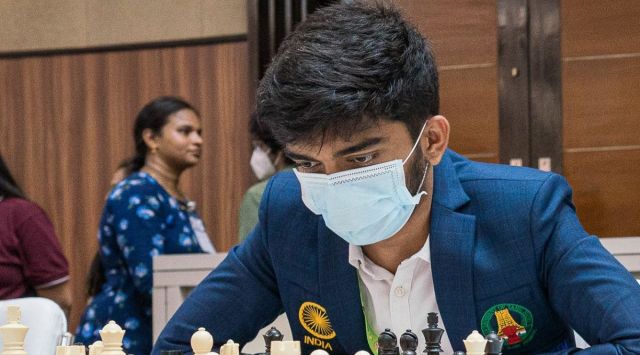Baiting the gambler: How Gukesh matched attack for attack before teasing Alexie Shirov with an offer he couldn’t refuse
With both counterpunching, the game turned on a pivotal moment when Gukesh created a favourable position for Shirov to consume his queen, by taking off a knight from his queenside path.
 The 16-year-old Indian appeared to have gained the advantage when he took a 1.5-0.5 lead(FILE)
The 16-year-old Indian appeared to have gained the advantage when he took a 1.5-0.5 lead(FILE)Palms wrapped over his stubbled cheeks, serene eyes magnetised onto the board, slanted frame still like a portrait painting, D Gukesh sat across his rival Alexei Shirov, in a deep, uninterrupted meditation, as though everything around him had blurred out and he just saw the pieces.
The imposing frame of the silver-haired Shirov loomed—literally and metaphorically. Gukesh might have to stand on his toes just to reach till his neck. He has to grow a few more inches taller to reach his stature, though they are just a few points adrift. Shirov, a disciple of the legendary Mikhail Tal, is considered as one of the most aggressive Grandmasters of the game, has authored several best-selling chess books, the seminal one Fire on the Board an equivalent of the The Bible among attacking players, and has fought several generations of Indian Grandmasters from Viswanathan Anand to Arjun Erigaisi.
But Gukesh remained undaunted. His eyes were locked on the board, and the intricate paths his pieces could trace, and not the rival. He began with a classical Sicilian defence, a semi-aggressive opening that protects the king. But the shrewd Shirov moved his pawn to d4, blocking the possibility of developing the opening to a more dynamic Sveshnikov defence. Shirov’s ploy was not only to attack but also to neutralise the attacking options of Gukesh. And he makes his moves so fast that he puts the opponent under pressure straightaway.
16-year-old @DGukesh is 5/5 at the #ChessOlympiad and has moved up the ranks to 27th in the world! 👏 pic.twitter.com/NRyxqZZ6IS
— Chess.com (@chesscom) August 2, 2022
The chess-savvy manager of Chelsea Thomas Tuchel had once equated the pressing game of Jurgen Klopp to Shirov’s style.
The early pressure is relentless, the 50-year-old tunes up all his pieces in attack mode, inducing mistakes that seldom go unpunished. “He’s like a hurricane,” Fabiano Caruana had once remarked. Weathering the early storm is key to strangling him, leave alone beating him.
Here is where Gukesh, and generally, this generation differs. Not for them a backward step, or a retreat; they repel the attacking game with an attacking game. What followed was a thrillingly nuanced game of punches and counterpunches, blows and counter-blows, with both players taking out each other’s pieces in a hurry, as though they were allergic to traffic blocks. After just the 15th move, both were a pawn, two bishops and a knight down. Then came a lull, as both looked to lay a trap, not elaborate ones but quick-fire one, and the match was on a fragilely even keel. One step, or misstep could turn the game’s tide.
Then Gukesh decided to lay the charm offensive that was to decide the outcome of the game. He created a favourable position for Shirov’s to consume his queen, by taking off a knight from his queenside path. It was a high-risk strategy, but he is not the one to slink back from a challenge. Shirov realised the folly soon after as Gukesh’s king consumed Shirov’s queen. Then Gukesh fortified his advantage with clever manoeuvring of his knights, emphasising once again the understated powers of the knights.
“My strategy was to provoke him and being an aggressive player, he could not resist aggressive moves, ones which I anticipated,” Gukesh said.
But Shirov would not surrender without a fight, without launching more attacks. Gukesh then decelerated to frustrate Shirov, who embraced more gambles, only to be thwarted by a still-still Gukesh. As if bound by a superstition, he remained in that semi-slouched meditative pose for much of the game. Someone had to touch and feel that he was not a figurine.
Finally, moving his king to e2, he stamped the ultimate authority over his celebrated rival and wrapped up the match in the 44th turn. His face was still inexpressive, shedding neither relief nor joy, as he shook hands with Shirov. Later, with a faint smile, he said: “It’s an honour to play him, to defeat him is special.”
The victory—his fifth in as many games, extending a red hot streak that he had struck at the start of the year—made him India’s third seed according to live ratings. It was just a few months that he became the youngest Indian and third youngest to cross the 2700 ratings. He is scaling peaks at rapid pace, and it’s hardly any wonder that he keenly follows the American free climber Alex Honnold, who has climbed some of the tallest mountains in the world without any protective gear. “One slip, he could die. But he never slips. That’s why I like him a lot. It’s like that in chess, one slip and you could lose,” he had once said.
The line was most applicable in the Shirov heist. Gukesh took risky trails, clung onto the wedges between rocks, and reached the summit, underlining his emergence as the most talented as well as exciting of India’s new wave of talents. Susan Polgar even tweeted that he would go the furthest among the new wave of Indian players.
The son of an ENT surgeon and a microbiologist, he has the most flexible game among Nihal Sarin, R Praggnanandhaa and Raunak Sadhwani. He is tactically and positionally strong, can oscillate between attack and defence, can lay traps and pull himself out of traps. And on days like these, he can be, to use the title of Shirov’s best work, Fire on the Board.































